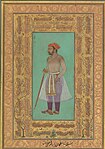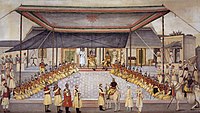Urdu-speaking people
اہلِ زبانِ اردو | ||
|---|---|---|
other Indian states, many speakers live in various cities in South India, mostly Hyderabad, Bangalore, Chennai )other large Pakistani cities )United Kingdom 270,000 (2011)[9] | | |
| 210,815 (2016)[10] | ||
| 69,131 (2016)[11] | ||
| Languages | ||
| Urdu | ||
| Religion | ||
| Islam, small minority Christianity and Judaism | ||
Native speakers of
The term "Urdu-speakers" does not encompass culturally non-native speakers who may use Urdu as a first or second language, which would additionally account for a much larger number of total speakers in South Asia.[12]
History
From the early Muslim kingdoms developed Indian Muslim clan-groups who were well-rooted social groups that acted as warrior lineages providing court officers and military soldiers. These evolving communities or tribes played a key role in providing a local Muslim leadership.[22] The language developed at the time of Sultans of Dehli due to the mixture of people, likely to be soldiers, from Turkish, Arabic, Persian, Afghan and Indian background.
Mughal Empire
As early as 1689, Europeans used the label "Moors dialect", which simply meant "Muslim",[23] to describe Urdu, the language associated with the Muslims in North India,[24] such as John Ovington, who visited India during the reign of Mughal emperor Aurangzeb:[25]
The language of the
Persians, or other Nations.
Fall of the Mughal Empire
The rural Upper Doab and Rohilkhand was dominated by a literate and homogenous elite, who embraced a distinctive Indo-Persian style of culture. This service gentry, performing both clerical and military service for the Mughal empire and its successor states, provided cultural and literary patronage that contninued, even after the political decilne, to act as preservers of Indo-Persian traditions and values.[26]
-
Cavalry in the Durbar Procession of Mughal Emperor Akbar II(reigned 1806-1837) under British rule
-
Regiment of Skinner's Horse returning from a General Review, 1828
-
Officer of Col Gardiner’s irregular Cavalry, "drawn mainly from Muslism from Hindoostan"[27]
-
Sowar of the Rohilla Horse, 1815
The end of Muslim rule saw a large number of unemployed
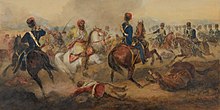
The Indian Rebellion of 1857 was initiated by the 3rd Bengal Light Cavalry in Meerut, which was composed mainly of Indian Muslims.[34] The mutineers made for Delhi, where its garrison revolted, massacring its British population, and installed Bahadur Shah Zafar as its nominal leader. The spread of the word that the British had been expelled from Delhi, interpreted as the breakdown of British authority, acted as a catalyst for mutiny as well as revolt. Regiments in other parts of northern India only revolted after Delhi had fallen.[35] British characterizations of Muslims as fanatics took the fore during and after the Great Rebellion, as well as produced the Indian Muslims as a unified, cogent group, who were easily agitated, aggressive, and inherently disloyal.[36]
Urdu nationalism
Even in later days, the same clans were dominant groups in the associations in the defence of Urdu and district Muslim Leagues which were among the first forays of Muslims into electoral and pressure-group politics.
Clans
The Biradari, a term of Persian origin literally translating to "brotherhood",[41] is the word used for a social unit based on kinship such as tribe or clan.[42] The chief of the Biradari is the "Sardar", who is usually an elder man annually elected as the greatest man in the Biradari. Decisions on important matters are taken only after consulting the Biradari, and once taken binding on every member, especially in rural life.[43]
Despite their tribal geneaologies tracing to foreign regions, these elites embellished rural seats and traditions within India, developing a sense of pride in home (watan). Families of Muslim service people from gentry families were bound together by tight marriage alliances, which often became permanent arrangements.[44] Bitter factionalism over between clans over land-rights was also a common feature of society.[45]
Bilgrami

The Sadaat-i
In the 20th century, Syed Hussain Bilgrami was one of the early leaders of the Muslim League.[49]
Barha
The
In the 20th century, Mohsin-ul-Mulk founded the Urdu Defence Association, or the Anjuman-i Taraqqi-i Urdu, committed to the perpetuation of the Urdu language.[4][57]
-
Saif Khan Barha, a favorite of the Mughal Emperor Jahangir
-
Court of theSayyid Brothersin the early 1700s
-
Mohsin-ul-Mulk, a Barha Syed of Etawah
Alvi

The
Ansari

The
Ranghar
The Ranghar were classified as an "agricultural tribe" by the British Raj administration and were recruited heavily in the British Indian Army ,[68] especially in Skinner's Horse. the Ranghars were the nucleus of the 3rd Bengal Light Cavalry which captured Delhi in 1857[29]
-
Regimental Durbar of Skinner's Horse, predominantly recruited from Ranghars
-
Skinner's Horse at Exercise, 1840 (c)
-
Skinner's Horse
Barabasti
-
An Indian Pathan
Lalkhani
The Lalkhanis are Muslim Rajput converts from the Bargujar tribe, who assimilated to Lalkhani identity after their conversion.[75] The Lalkhanis held estates in the districts of Bulandshahr.[76] Nahar Ali Khan, who received the Taluqa of Pitampur from the Emperor Shah Alam II in 1774, offered resistance against the East India Company with his nephew Dunde Khan.[77] Mir Muhammad Baquar Ali Khan was the Raja Of Pindrawal while Nawab Saeed-ul-Mulk Chhatari, the last Prime Minister of the Nizam of Hyderabad, was one of the most prominent politicians of the All-India Muslim League.[75]
-
Raja Mir Jaffer Ali Khan
-
Nawab Chhatari with Syedna Tahir
-
Qasim Ali Khan son of Raja Akbar Ali Khan saheb from Pindrawal
Gardezi
The Gardezi tribe of Manikpur are an Indian community of Sayyids who had settled in Manikpur since the 12th century.[78] In the 1700s, Raji Muhammad Khan who belonged to the Gardezi tribe of Manikpur was the Mir-i-Atish, or artillery chief, of the Mughal Emperor Jahandar Shah after he had blown up prince Jahan Shah's powder magazines.[79]
Bangash

The first immigrants to Mau were the descendants of the Khwaja Bayazid Ansari, the ethnic
Being few in number, the bulk of Muhammad Khan's soldiers were elite slaves known as 'disciples', primarily Hindu Rajputs and sometimes Brahmins who were adopted, converted to Islam and submitted to a regime of religious, literary and military training which was focused on the transformation of the recruit's identity, who played a significant role as a kind of artificial family in-group attached to their patron. Before Muhammad Khan's death, the separation between the various tribes and castes broke down, forming a homogenous group, so that Muhammad Khan had founded his own Indian Muslim tribe or caste. To increase his independence from his nobles further, he continued to encourage immigration of Pashtuns of the Bangash and Afridi clan in Tirah. In India they were referred to as qaum-i-bangash which became a wider and more diffused label. [85]Turk
1.5 million residents in the regions of Moradabad, Amroha and Sambhal, belonging to an Indian Muslim brotherhood descending from Turks, primarily from the era of the Delhi Sultanate. According to Professor Abhay Singh, these community originate from the era of the Turkan-e-Chahalgani, the Corps of Forty Turkic slave emirs, whose power was broken up by Ghiyas ud din Balban, and as a result they fled and settled down in the different villages of Katehr, near Badayun which was an important centre of the empire. They primarily speak Urdu and are Indian Muslims in customs, traditions, and language.[86] Suspicious of outside interference, the Turk villages are closely knit together into a Biradari (brotherhood) whose affairs are controlled by annually elected Sardars, the chief of the Biradari. they control all the activities of the community both internally and in relation with the outside world. The delinquent is severely ostracised which in their parlance, the man punished is not respectable enough to smoke the same Huqqa or drink from the same bowl as the honourable Biradari. If the offender repends and expresses a desire to retrieve his guilt, he must atone by means of a grand feast to the community. Occasions of celebration in the villages include the event of Ghazi Salar Masud's invasion on his way to Bahraich, which are celebrated with wrestling and fencing matches.[87]
Amrohi Sadaat

The Sadaat-i-Amroha belong mainly to the
Rohillas of Shahjahanpur
The first use of the term Rohilla was in the 1600s, to refer to the community of Diler Khan Rohilla, who was born in India,[94] and was the founder of his community in Shahjahanpur and Hardoi.[95] This community over generations had become culturally closer to the Awadh than to the Rohillas of Rampur, and sympathized with the Nawab of Awadh.[96] A large number were recruited in the army of Ghulam Muhammad Khan of Rampur during the Second Rohilla War. A large number led by Diler Khan betrayed the Nawab of Rampur and defected to the side of the Nawab of Awadh.[97][98][99] Khan Barkat Ali Khan who belonged to the Shahjahanpur Pathans as a risaldar rendered services to the British during the Anglo-Sikh War of 1848. After his retirement he settled down in Lahore and devoted work to the Anjuman-i-Islamiya. He gave constant support to the Aligarh Movement and to Sayyid Ahmad Khan, and was instrumental in the establishment in the first Girls School at Lahore.[100]
Muslim Kambohs

The Kamboh tribe likely originated in northwest India.
Qidwai
The Qidwai are a tribe of Indian Muslims who claim descent from the Bani Israil.[104] The Qidwai were recruited in the household cavalry of Shuja-ud-Daula, which was mainly composed of the Sheikhzadi.[105][104] These clans had not taken any profession other than a soldier or a civil officer.[106] Abdul Majid Daryabadi belonged to the Qidwai clan in Daryabad.[107]
Bukhari Sayyid
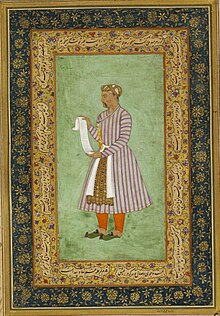
Medieval sources refer to a specific group of Indian Shaikhzadas called the Bukhari Sayyids. These were descendants of
Culture
Qasbas
In Urdu, the word qasba refers to a settlement larger than a village but smaller than a city; in short, a town. In India, a qasba is a small town distinguished by the presence of Muslim families of rank.[111]
Cuisine
Cultural affinity meant that
-
Roghni Naan
-
Seekh Kabab
-
File:Qorma sheermaal kheer.jpg
-
Mutton Nihari
-
Biryani
Geographic distribution
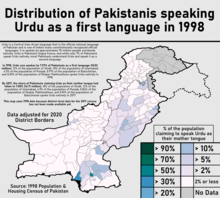
Although the majority of Urdu-speakers reside in
The Urdu-speaking community is also present in other parts of
In addition, there are Urdu-speakers present amongst the South Asian diaspora, most notably in the
See also
Notes
- Modern Standard Hindias a separate entity statistically.
- British India, North Indian people of many faiths, including Hindus, self-identified as Urdu-speakers prior to the mid-19th century, after which they self-identified as Hindi-speakers.
References
- ^ Urdu at Ethnologue (22nd ed., 2019)

- ^ "Census of India 2011: Language" (PDF). Office of the Registrar General and Census Commissioner of India. 2011. Retrieved 28 May 2020.
- ^ "POPULATION BY MOTHER TONGUE, SEX AND RURAL/ URBAN" (PDF). pbs.gov.pk. Pakistan Bureau of Statistics. 2017. Retrieved 2023-03-14.
- ^ a b Hasnain, Khalid (2021-05-19). "Pakistan's population is 207.68m, shows 2017 census result". Dawn. Archived from the original on 2022-10-17. Retrieved 2022-11-12.
- ^ ISBN 978-1-135-19395-9.
- ^ National Statistics Office (2021). National Population and Housing Census 2021, Caste/Ethnicity Report. Government of Nepal (Report).
- ^ "Detailed Languages Spoken at Home and Ability to Speak English for the Population 5 Years and Over for United States: 2009-2013".
- ^ "Citizenship for Bihari refugees". BBC News. 19 May 2008. Retrieved 19 July 2020.
- ^ "2011 Census: Quick Statistics". Office for National Statistics. Retrieved 11 April 2015.
- ^ "Census Profile, 2016 Census, Canada". Government of Canada, Statistics Canada. 8 February 2017. Retrieved 6 October 2020.
- ^ a b Ali, Waqar (23 November 2018). "Find out how many people speak Urdu in your suburb". SBS News. Retrieved 19 July 2020.
- ^ ISBN 978-3-319-32754-9.
- ISBN 978-81-88965-15-1.
- ISBN 978-93-5118-725-7.
- ISBN 978-1-64259-380-8.
The language known variously as Urdu/Hindi/Hindustani, and in an earlier era, Hindavi, was born on the streets and in the bazaars of North India. Khari Boli, spoken in and around Delhi and what is now western Uttar Pradesh, is the base language of which the Persian lexicon came to be added. Urdu, written in the Persian-Arabic script, was spoken by Hindus and Muslims across North India and the Deccan Plateau. ... The partitioning orf Urdu began in earnest in the second half of the nineteenth century, after the failed 1857 Ware of Independence (known to the British as the Mutiny), when India ceased to be merely an asset of the East India Company.
- ISBN 978-1-137-32505-1.
Urdu is a stylized version of the colloquial language spoken by both Muslims and Hindus in what is now central north India.
- ISBN 978-1-137-02692-7.
Historically speaking, Urdu grew out of interaction between Hindus and Muslims. He noted that Urdu is not the language of Muslims alone, although Muslims may have played a larger role in making it a literary language. Hindu poets and writers could and did bring specifically Hindu cultural elements into Urdu and these were accepted.
- ^ ISBN 978-1-317-33593-1.
- ISBN 978-1-134-71319-6.
Historically, Urdu developed from the sub-regional language of the Delhi area, which became a literary language in the eighteenth century. Two quite similar standard forms of the language developed in Delhi, and in Lucknow in modern Uttar Pradesh. Since 1947, a third form, Karachi standard Urdu, has evolved.
- ISBN 978-2-7637-7186-1.
Modern Urdu is a fairly homogenous language. An older southern form, Deccani Urdu, is now obsolete. Two varieties however, must be mentioned viz. The Urdu of Delhi, and the Urdu of Lucknow. Both are almost identical, differing only in some minor points. Both of these varieties are considered 'Standard Urdu' with some minor divergences.
- ISBN 978-1934536568.
- ISBN 978-0-19-908873-7.
- ^ sir Richard Francis Burton, Luis Vaz de Camoens (1881). Camoens: his life and his Lusiads, a commentary: Volume 2. Oxford University. p. 573.
- ISBN 9788186062104.)
{{cite book}}: CS1 maint: multiple names: authors list (link - ^ John Ovington (1994). A Voyage to Surat in the Year 1689. Asian Educational Services. p. 147.
- ISBN 9780520064393.
- ^ Narindar Saroop (1983). Gardner of Gardner's Horse, 2nd Lancers, Indian Army. Abhinav Publications. p. 67.
- ISBN 978-0-19-569815-2.
- ^ ISBN 9788170623311.
- ^ Calcutta Review 1956. University of Calcutta. 1956. p. 38.
- ISBN 9780521663601.
- ISBN 9780230337626.
- ISBN 9780521898454.
- ^ Ikram ul-Majeed Sehgal (2002). Defence Journal:Volume 5, Issues 9-12. University of Michigan. p. 37.
- ISBN 9788178240275.
- ISBN 9781786732378.
- ^ C.A. Bayly (2012). Rulers, Townsmen and Bazaars North Indian Society in the Age of British Expansion: 1770–1870.
- ^ R. Upadhyay. "Urdu Controversy – is dividing the nation further". South Asia Analysis Group. Archived from the original on 11 March 2007.
- )
- ISBN 9788126903146.
- ISBN 9780226615936.
- ISBN 9780520970533.
- ^ Khan Amanat (1938). Agriculture and Live Stock In India Vol-viii. The Imperial Council Agriculture Research. p. 485.
- ISBN 978-0-19-908873-7.
- ISBN 9780521310543.
- ^ Essays in Arabic Literary Biography: 1350 - 1850, Roger M. A. Allen, Joseph Edmund Lowry, Terri DeYoung, Devin J. Stewart, Otto Harrassowitz Verlag, 30-Dec-2009
- ^ People of India Uttar Pradesh Volume XLII Part Three edited by A Hasan & J C Das
- ^ Muzaffar Alam (1986). The Crisis of Empire in Mughal North India. Oxford University Press, Bombay. p. 21.
- ^ "Eminent Mussalmans". archive.org. Retrieved 2016-03-29.
- ^ William Irvine (1971). Later Mughal. Atlantic Publishers & Distri. p. 202.
- ISBN 9781139501231.
- ^ William Irvine (1971). Later Mughal. Atlantic Publishers & Distri. p. 202.
- ^ Rajasthan Institute of Historical Research (1975). Journal of the Rajasthan Institute of Historical Research: Volume 12. Rajasthan Institute of Historical Research.
- ISBN 978-9-38060-734-4.
- ^ Mohammad Yasin. Upper India Publishing House. 1958. p. 18.
- ^ Mohammad Yasin (1958). A Social History of Islamic India, 1605-1748. p. 18.
- ^ Muslim Politics and Leadership in the South Asian Sub-continent |publisher=Institute of Islamic History, Culture and Civilization, Islamic University (Islamabad)
- ^ "ARIF ALVI". Pakistan Tehreek-e-Insaf. 20 May 2017.
- ^ People of India: Uttar Pradesh, Volume XLII, edited by A. Hasan & J. C. Das, p. 1301.
- ISBN 9781526788634.
- ISBN 9788174881380.
- ^ Syeda Saiyidain Hameed, 'Introduction', Hali's Musaddas: A Story in Verse of the Ebb and Tide of Islam (New Delhi: HarperCollins, 2003), p. 24.
- ISBN 9780195478112
- ^ Indo-iranica: Volume 29. Iran Society (Kolkata, India). 1976.
- ^ Ansaris of Yusufpur, Mahmud Ansari, 2013
- ^ https://www.heritagetimes.in/mukhtar-ansari/
- ^ https://www.britannica.com/biography/Mukhtar-Ahmad-Ansari
- ISBN 978-81-7824-059-6.
- ^ Proceedings:Volume 55. Indian History Congress. 1995. p. 435.
- ^ Henry Walter Bellew (1891). An Inquiry Into the Ethnography of Afghanistan. Oriental University Institute.
- ^ Kripal Chandra Yadav (1980). Delhi in 1857: Volume 1. Academic Press. p. 294.
- ^ Yadav (1980). Delhi in 1857: The trail of Bahadur Shah. Academic Press. p. 294.
- ^ Fleetwood Williams (1858). Narrative of Events Attending the Outbreak of Disturbances and the Restoration of Authority in the District of Meerut in 1857-58. Government Press. p. 59.
- ^ Bengal, Past & Present:Journal of the Calcutta Historical Society · Volume 86. Calcutta Historical Society. 1967. p. 47.
- ^ a b People of India Uttar Pradesh Volume XLII Part Two edited by A Hasan & J C Das
- ISBN 9780521048262.
- ^ Prag Narain Bhargava (1911). Who's who in India:Parts 4-8. Newul Kishore Press.
- ^ William Charles Benett (1870). A Report on the Family History of the Chief Clans of the Roy Bareilly District. p. 5.
- ^ William Irvine (1971). Later Mughal. p. 186.
- ISBN 978-1-64249-882-0.
- ISBN 9781351363563.
- ISBN 9781405157612.
- ^ Journal of the Asiatic Society of Bengal:Volume 47. Asiatic Society (Kolkata, India), Asiatic Society of Bengal. 1878. p. 331.
Muhammad Khan, being a mere soldier, did not understand a single word of Persian, Turki or Pushtu
- ^ Irvine, William (1879). A History of the Bangash Nawabs of Farrukhabad: From 1713 to 1771 A.D. G.H. Rouse.
- ^ C. A. Bayly (1988). Rulers, Townsmen and Bazaars:North Indian Society in the Age of British Expansion, 1770-1870. p. 119.
- ^ PRIYANGI AGARWAL (Oct 7, 2015). "Istanbul opens its eyes to Rohilkhand's 11 lakh Turks". The Times of India.
- ^ Khan Amanat (1938). Agriculture and Live Stock In India Vol-viii. The Imperial Council Agriculture Research. p. 486.
- ^ Calcutta Review 1956. University of Calcutta. 1956. p. 38.
- ISBN 978-0-19-908873-7.
- ^ Proceedings:Volume 50. Indian History Congress. 1990.
- ^ Poonam Sagar (1993). Maratha Policy Towards Northern India. Meenakshi Prakashan. p. 158.
- ISBN 9789384544317.
- ISBN 9781482814781.
- ^ Athar Ali (1968). The Mughal Nobility Under Aurangzeb. p. 251.
Dilir Khan Rohela - Birthplace: India
- ^ William Irvine (1971). Later Mughal. p. 117.
- ISBN 9788170462132.
- Aljazeera.com. 6 May 2013.
- ^ .L. Drake-Brockman (1909). District Gazetteers of the United Provinces of Agra and Oudh: Shahjahanpur. Supdt., Government Press, United Provinces.
- ISBN 9788170462132.
Shahjahanpur, indeed, lying on the border between Awadh and Rohilkhand, formed a sort of debatable land between the two provinces but the sympathies and connections of the Shahjahanpur Pathans lay always with Awadh rather than the
- ISBN 9788171563746.
- ISBN 9788120605053.
- ^ John Forbes Watson (1873). A Classified and Descriptive Catalogue of the Indian Department. p. 10.
- ^ A. Vadivelu (1915). The Ruling Chiefs, Nobles and Zamindars of India.
- ^ ISBN 9788172232887.
- ^ Pradeep Barua (2005). The state at war in South Asia. p. 73.
- ^ Surya Narain Singh. Mittal Publications. 2003. p. 9.
- ^ Mabood 2019, p. 36.
- ^ Kenneth Pletcher. The History of India. Rosen Publishing Group.
- ^ Ellison Banks Findly (1993). Nur Jahan: Empress of Mughal India. Oxford University Press.
- ^ Nasir Raza Khan. Islam in India: History, Politics and Society. Manakin Press. p. 86.
- ^ E. A. Mann (1992): Boundaries and Identities: Muslims, Work and Status in Aligarh, p. 23: "A qasbah is a small town distinguished by the presence of 'decent people or families of some rank' (Platts, 1974)."
- ISBN 9789351185758.
- ISBN 9780313376269.
- ^ "Pakistani food debate: Team Biryani Vs Team Pulao, who will win?". gulfnews.com. 20 January 2022. Retrieved 2023-01-02.
- ISBN 978-1-107-17114-5.
- ISBN 978-1-136-22032-6.
- ^ "Madhesh". Unrepresented Nations and Peoples Organization. 2020. Retrieved 16 July 2020.
- JSTOR 20840072.
- ISBN 978-1-78308-447-0.
- ISBN 978-81-8475-094-2.
Superstar Salman Khan is a Pashtun from the Akuzai clan...One has to travel roughly forty-five kilometres from Mingora towards Peshawar to reach the nondescript town of Malakand. This is the place where the forebears of Salman Khan once lived. They belonged to the Akuzai clan of the Pashtun tribe...
- ^ Swarup, Shubhangi (27 January 2011). "The Kingdom of Khan". Open. Archived from the original on 4 June 2020. Retrieved 6 June 2020.
- ^ Alavi, Shams Ur Rehman (11 December 2008). "Indian Pathans to broker peace in Afghanistan". Hindustan Times.
Pathans are now scattered across the country, and have pockets of influence in parts of UP, Bihar and other states. They have also shone in several fields, especially Bollywood and sports. The three most famous Indian Pathans are Dilip Kumar, Shah Rukh Khan and Irfan Pathan. "The population of Pathans in India is twice their population in Afghanistan and though we no longer have ties (with that country), we have a common ancestry and feel it's our duty to help put an end to this menace", Atif added. Academicians, social activists, writers and religious scholars are part of the initiative. The All India Muslim Majlis, All India Minorities Federation and several other organisations have joined the call for peace and are making preparations for the jirga.
- ^ ISBN 978-0-520-29413-4.
- JSTOR 20837002.
- ^ ISBN 1-134-71320-7.
- ISBN 978-0-8047-5442-2.
- ^ ISBN 978-1-134-77970-3.
- ISBN 978-1-315-30337-6.
- ISBN 978-0-85772-139-6.
External links
- Alavi, Shams Ur Rehman (Jul 2018). "Census Data on Language Reveals a Surprise about Urdu". The Wire. Retrieved 18 July 2020.
- Daniyal, Shoaib (Jul 2018). "Surging Hindi, shrinking South Indian languages: Nine charts that explain the 2011 language census". Scroll.in. Retrieved 18 July 2020.



![Officer of Col Gardiner’s irregular Cavalry, "drawn mainly from Muslism from Hindoostan"[27]](http://upload.wikimedia.org/wikipedia/commons/thumb/e/eb/An_Officer_of_Col_Gardiner%E2%80%99s_irregular_Cavalry.jpg/200px-An_Officer_of_Col_Gardiner%E2%80%99s_irregular_Cavalry.jpg)

